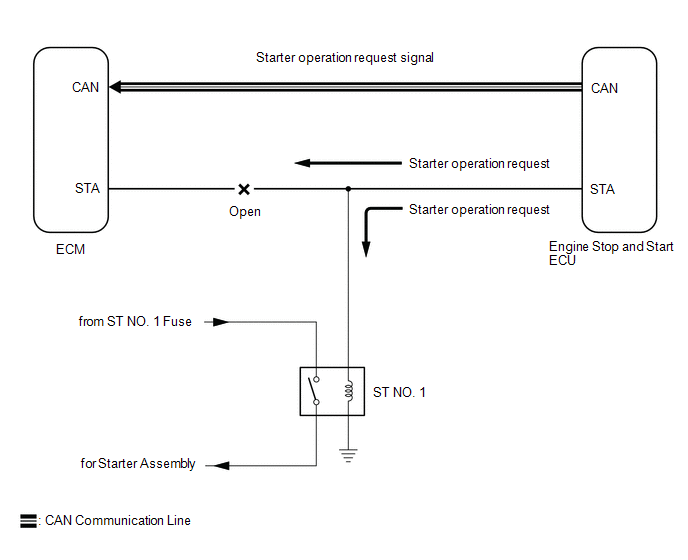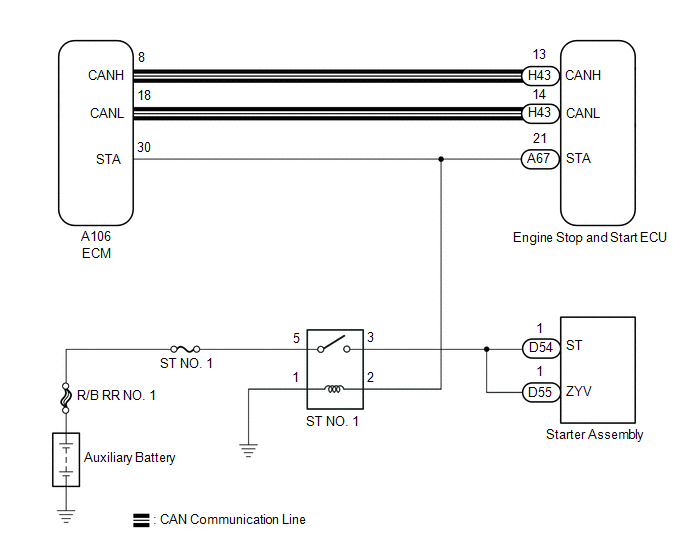Toyota Yaris: Stop And Start System / STA Signal Circuit
DESCRIPTION
While the engine is being cranked, a starter operation request signal is sent to terminal STA of the ECM.
HINT:
If there is an open in the STA circuit of the ECM, stop and start control will be prohibited after the third time the engine is started by stop and start control.
- Stop and start control will be prohibited until the ignition switch is turned off.
- The MIL will not illuminate.
- If there is an open in the STA circuit of the ECM, the engine can still be started using the ignition switch, as the ECM also receives the starter operation request signal from the engine stop and start ECU via CAN communication. (Stop and start control is prohibited as the reliability of the signal sent via CAN communication cannot be assured while the voltage drops during operation of the starter assembly.)

WIRING DIAGRAM

PROCEDURE
| 1. | READ VALUE USING GTS (STARTER SW) |
| Tester Display |
|---|
| Starter SW |
(a) Read the values displayed on the GTS when the ignition switch is ON and on (START).
OK:
| GTS Display | Switch Condition | Normal Condition |
|---|---|---|
| Starter SW | Ignition switch ON | OFF |
| Ignition switch START | ON |
| OK |
 | PROCEED TO NEXT SUSPECTED AREA SHOWN IN PROBLEM SYMPTOMS TABLE |
|
| 2. | CHECK HARNESS AND CONNECTOR (ECM - ST NO. 1 RELAY) |
(a) Disconnect the A67 engine stop and start ECU connector.
(b) Disconnect the A106 ECM connector.
(c) Remove the ST NO. 1 relay from the No. 1 engine room relay block and No. 1 junction block assembly.
(d) Measure the resistance according to the value(s) in the table below.
Standard Resistance:
| Tester Connection | Condition | Specified Condition |
|---|---|---|
| A106-30 (STA) - ST NO. 1 relay terminal 2 | Always | Below 1 Ω |
| OK |
 | PROCEED TO NEXT SUSPECTED AREA SHOWN IN PROBLEM SYMPTOMS TABLE |
| NG |
 | REPAIR OR REPLACE HARNESS OR CONNECTOR |
 Failure to Restart from IG-ON Engine Stall
Failure to Restart from IG-ON Engine Stall
DESCRIPTION
This is the troubleshooting procedure for situations where the engine does not restart when attempting to restart it after either a failed engine start occurred under stop and start system control, or a mis-operation during vehicle takeoff resulted in an engine stall...
 Stop And Start System Cancel Switch Assembly
Stop And Start System Cancel Switch Assembly
ComponentsCOMPONENTS ILLUSTRATION
*1 ECO RUN CANCEL SWITCH ASSEMBLY (COMBINATION SWITCH ASSEMBLY) - - RemovalREMOVAL PROCEDURE 1. REMOVE ECO RUN CANCEL SWITCH ASSEMBLY (COMBINATION SWITCH ASSEMBLY) Click here
InspectionINSPECTION PROCEDURE 1...
Other information:
Toyota Yaris XP210 (2020-2025) Reapir and Service Manual: Terminals Of Ecu
TERMINALS OF ECU CHECK CERTIFICATION ECU (SMART KEY ECU ASSEMBLY) (a) Disconnect the H46 certification ECU (smart key ECU assembly) connector. (b) Measure the voltage and resistance according to the value(s) in the table below. Tester Connection Terminal Description Condition Specified Condition Related Data List Item H46-29 (E) - Body ground Ground Always Below 1 Ω - H46-6 (+B) - H46-29 (E) Power supply Always 11 to 14 V - H45-22 (CUTB) - H46-29 (E) Dark current cut pin* Ignition switch off 11 to 14 V - *: In order to prevent the vehicle auxiliary battery from being depleted when the vehicle is shipped long distances, a fuse that cuts unnecessary electrical load while the vehicle is being shipped is installed in the circuit...
Toyota Yaris XP210 (2020-2025) Reapir and Service Manual: Data List / Active Test
DATA LIST / ACTIVE TEST DATA LIST NOTICE: In the table below, the values listed under "Normal Condition" are reference values. Do not depend solely on these reference values when deciding whether a part is faulty or not. HINT: Using the GTS to read the Data List allows the values or states of switches, sensors, actuators and other items to be read without removing any parts...
Categories
- Manuals Home
- Toyota Yaris Owners Manual
- Toyota Yaris Service Manual
- G16e-gts (engine Mechanical)
- Adjustment
- Auto Lock/Unlock Function
- New on site
- Most important about car
Supplemental Restraint System (SRS) Precautions
The front and side supplemental restraint systems (SRS) include different types of air bags. Please verify the different types of air bags which are equipped on your vehicle by locating the “SRS AIRBAG” location indicators. These indicators are visible in the area where the air bags are installed.
The air bags are installed in the following locations:
The steering wheel hub (driver air bag) The front passenger dashboard (front passenger air bag) The outboard sides of the front seatbacks (side air bags) The front and rear window pillars, and the roof edge along both sides (curtain air bags)
